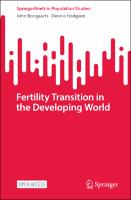Fertility Transition in the Developing World
| dc.contributor.author | Bongaarts, John | |
| dc.contributor.author | Hodgson, Dennis | |
| dc.date.accessioned | 2022-09-15T20:13:49Z | |
| dc.date.available | 2022-09-15T20:13:49Z | |
| dc.date.issued | 2022 | |
| dc.identifier | ONIX_20220915_9783031118401_23 | |
| dc.identifier.uri | https://library.oapen.org/handle/20.500.12657/58371 | |
| dc.description.abstract | This open access book provides an overview and analysis of the causes and consequences of the massive and highly consequential transition in reproductive behaviour that occurred in Asia, Latin America, and Africa since the mid-20th century. In the 1950s contraceptive use was rare and women typically spend most of their reproductive years bearing and rearing children. By 2020 fertility and contraceptive use in Asia and Latin America reached levels commonly observed in the developed world. Africa’s fertility is still high, but transitions have started in all countries. This monograph is the first to provide a comprehensive analysis of these trends and their determinants, covering changes in reproductive behaviour (e.g., use of contraception and abortion), preferences (e.g., desire to limit and space births) and the role of socioeconomic development (e.g., education). The role of government policies and in particular family planning programs is discussed in depth. Particular attention is given to provide a balanced assessment of several political and scientific controversies that have beset the field. As such this book provides an interesting read for a wide audience of undergraduate and graduate students, researchers, and public health policy makers. | |
| dc.language | English | |
| dc.relation.ispartofseries | SpringerBriefs in Population Studies | |
| dc.subject.classification | thema EDItEUR::J Society and Social Sciences::JH Sociology and anthropology::JHB Sociology::JHBD Population and demography | en_US |
| dc.subject.classification | thema EDItEUR::K Economics, Finance, Business and Management::KC Economics::KCP Political economy | en_US |
| dc.subject.classification | thema EDItEUR::M Medicine and Nursing::MB Medicine: general issues::MBN Public health and preventive medicine | en_US |
| dc.subject.other | Fertility transition | |
| dc.subject.other | Developing world | |
| dc.subject.other | Determinants of fertility | |
| dc.subject.other | Family planning programs | |
| dc.subject.other | Population policies | |
| dc.subject.other | Fertility policies | |
| dc.subject.other | Fertility trends | |
| dc.subject.other | Fertility decline | |
| dc.subject.other | Fertility preferences | |
| dc.subject.other | Socio-economic determinants in fertility decline | |
| dc.subject.other | Demographic transition | |
| dc.subject.other | Impact of population policies | |
| dc.subject.other | Political controversy over population policy | |
| dc.subject.other | Reproductive behaviour transition | |
| dc.title | Fertility Transition in the Developing World | |
| dc.type | book | |
| oapen.identifier.doi | 10.1007/978-3-031-11840-1 | |
| oapen.relation.isPublishedBy | 6c6992af-b843-4f46-859c-f6e9998e40d5 | |
| oapen.relation.isFundedBy | 5e435379-fea5-4c4d-8138-554d2afd4d07 | |
| oapen.relation.isbn | 9783031118401 | |
| oapen.imprint | Springer International Publishing | |
| oapen.pages | 144 | |
| oapen.place.publication | Cham | |
| oapen.grant.number | [...] |

